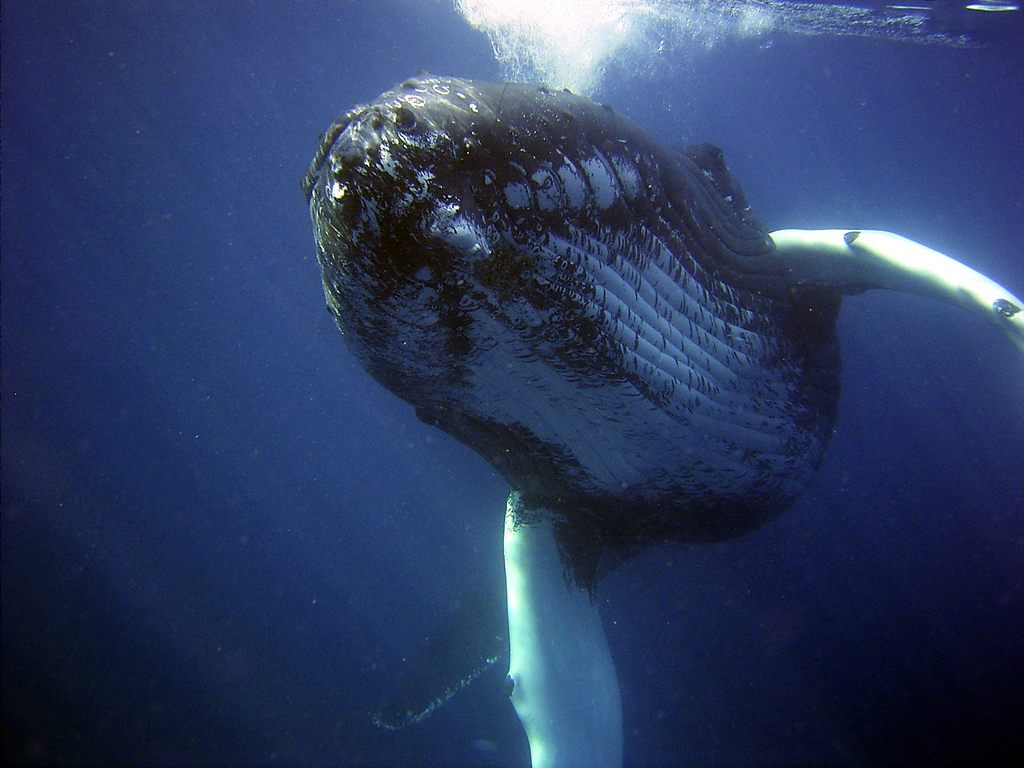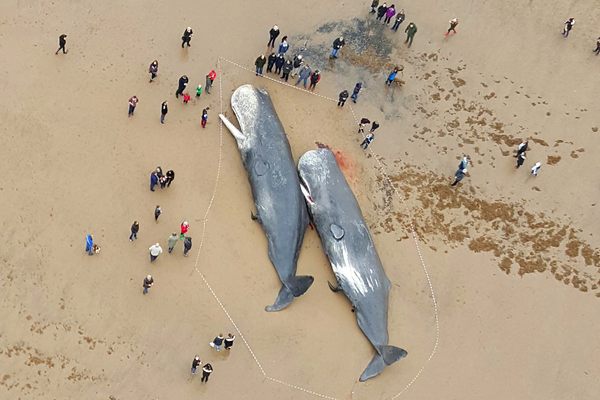Every Dead Whale Has a Tale to Tell
An introduction to cetacean forensics.

By the time vultures began circling, the young humpback whale was lying in a sea of brown and green, not blue. Beached and bloating in a mangrove forest on the Brazilian island of Marajó, near the mouth of the Amazon River, the 10-ton, year-old whale was surrounded by a tangle of leaves, branches, and roots.
The animal was dead, that much was obvious to the team that approached it, as they tripped over brush and flushed birds into the sky. Determining how, when, and where it died—and how it had ended up more than 50 feet from the shore, far from where one might expect—was a bit harder to puzzle out.
It’s not especially unusual for dead whales to turn up on land. When they do, their bodies hold mysteries for scientists to solve. Ancient remains might lead to insights into historical climate and changes in the ocean. (In 2014, for instance, a team of researchers led by paleobiologists from the Smithsonian Institution found more than 40 individual cetaceans, including some representing long-extinct species, in what amounted to a mass grave in Chile’s Atacama Desert, where they concluded that the animals had probably all died in different algal blooms.) When scientists come across more recently dead animals, the investigation is more or less forensic, which means that there’s a set of clues for every unknown.

When whales die, they either sink to the seafloor or wash up on land, eventually. Those ones that reach the bottom of the ocean become what’s known as whale fall—essentially, a heaping buffet that can support entire ecosystems—while wind, currents, and waves bring others ashore. When they show up farther inland, like the one in Brazil, it’s usually safe to assume that they were put there by storms or by humans, who might have wanted to give the creature a ceremonial burial or clean its bones for a museum or university, harvest the flesh for food, invite scavengers to pick the bones bare, or just stash a smelly carcass away. (If interred somewhere between the high and low tide marks—which vary by place and season—a whale carcass is likely to resurface “like Brigadoon above the sand,” says Joy Reidenberg, a comparative anatomist and professor at Icahn School of Medicine at Mount Sinai in New York, who specializes in the anatomy of whales and other large aquatic animals.) In this case, researchers from the marine conservation group Bicho D’Água, who inspected the whale, told The Independent that they suspect that it had been cast inland by high tides under a full moon.
Wherever it’s found, a whale carcass also holds clues about the cause and time of death. The Independent reported that researchers from Bicho D’Água have already given the animal a once-over and sent samples to a lab for analysis. Those results haven’t yet been reported, and the organization has not responded to Atlas Obscura’s requests for comment. But “there’s lots of forensics stuff before you even open it up,” says Reidenberg, who did not examine this whale, but looked at photographs. “It becomes a medical examiner case.”

First, the whale’s body position can indicate whether it was dead or alive when it washed ashore. Sick, weary whales seek solace in shallow, protected areas, “to basically rest, the way you’d want to stay in bed if you have the flu,” Reidenberg says. If they die there, they will land on shore belly-down. Waves or bloat may rock a carcass onto its side or back, but usually a fresh, belly-up carcass will already have been dead when it reaches the shore, Reidenberg says. Floating baleen whale carcasses tend to turn that way because methane and other gases from decomposition accumulate in their long, expandable, pleated throats. On dead humpbacks, these pleats—which stretch from below the mouth to the navel—function something like “a giant life-preserver,” Reidenberg says. Because this young whale was found with its belly turned skyward, Reidenberg suspects that it was already dead by the time it reached the mangroves, where its body may have snagged on roots.
The animal’s flesh might also yield hints about cause of death, Reidenberg says. Humpbacks’ lifespan may be up to 80 years, according to the National Oceanic and Atmospheric Administration (NOAA). When whales die young, it’s often because they fall victim to nets or other fishing gear. This is known as bycatch, and it’s thought to be responsible for the deaths of hundreds of thousands of cetaceans each year, according to the International Whaling Commission (IWC). Ship strikes can also be fatal, and are likely underreported because they may go unnoticed on very large vessels such as cruise liners or cargo ships, says the IWC, which is managing an ongoing project to map “hotspots” where whale populations overlap with shipping corridors. A whale’s flesh might show bruising, rust stains, or paint from such an incident, or bite marks from a shark, maybe, or deep slices carved by a propeller, or grooves from being ensnared in a rope. Bicho D’Água told the local news site G1 that they would examine the body for any signs that it had been entangled or struck.
The skin is an indicator that can point to the time of death. In the case of the humpback in Brazil, the animal’s characteristically inky skin had peeled off, leaving behind a grayish white, the color of a scuffed rubber sole. That indicates that the carcass wasn’t fresh when it was found, Reidenberg says, noting that the temperature of the water can impact the rate of sloughing. And just like human remains, the presence, size, and development of maggots can help further refine the timeline of when a whale began to decompose on land. (Maggots aren’t likely to appear out to sea, but birds could begin working away at a carcass while it is still in the water, Reidenberg says.)

Scientists may also make an incision and look inside for a necropsy—the animal equivalent of a human autopsy. Researchers might find an enlarged organ or tumor, pus or other signs of a bacterial infection, or cracked vertebrae that could suggest a traumatic accident not otherwise visible on the surface. An empty stomach could indicate that the animal had been sick and forgoing food (or milk, in the case of a calf). A visible parasite load—such as worms that look like “giant spaghetti strands,” as thick as a human pinky finger—might lead researchers to wonder if an organ had been obstructed, or at least indicate that the animal wasn’t in great overall health before it died, Reidenberg adds. There’s also evidence to suggest that animals fleeing loud sonar by bolting up in the water column might end up with dangerous nitrogen bubbles in their vessels and tissues—just like a human diver with the bends, or decompression sickness. This may be an issue for pods of deep-diving toothed whales, such as sperm whales, Reidenberg says, which dive to more than 3,200 feet, but less of a concern for filter feeders that stay near the surface.
A dead whale in a forest may seem like a locked-room mystery, but it’s not all that surprising, except for the fact that it is unusual for a humpback to be found in the waters around Brazil at this time of year. Milton Marcondes, a research coordinator at Brazil’s Humpback Whale Institute, told LiveScience that the number of whales in local waters has recently increased, and local tides can fluctuate by more 23 feet, more than enough to move a whale carcass inland.
With a little forensic work, cracking this case might prove to be easier than actually moving the body. Brazilian officials have concluded that bulldozers or other heavy-duty vehicles that could move the whale carcass for dissection or burial won’t be able to navigate the terrain around it, The Independent reported. The hope, according to local news outlets, is that when the bones are picked clean by vultures, other scavengers, and insects, the skeleton will be able to be moved to a nearby museum.



























Follow us on Twitter to get the latest on the world's hidden wonders.
Like us on Facebook to get the latest on the world's hidden wonders.
Follow us on Twitter Like us on Facebook